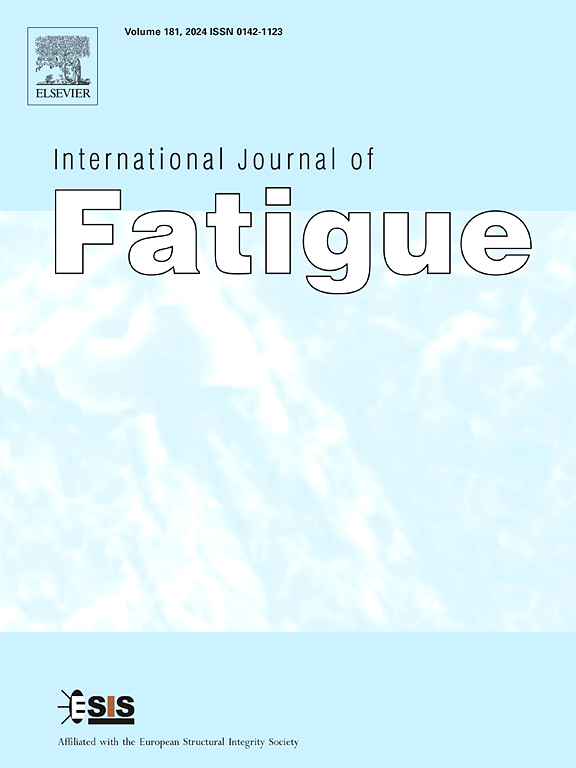Evolution of cable corrosion characteristics and life reliability analysis for cable stayed bridges
IF 5.7
2区 材料科学
Q1 ENGINEERING, MECHANICAL
引用次数: 0
Abstract
Corrosion fatigue of high-strength steel wires is a critical factor influencing the durability and reliability of cable-stayed bridges. In this study, high-strength steel wires were subjected to natural corrosion, stress-free accelerated corrosion, and stress-accelerated corrosion tests. The corrosion pit characteristics of the steel wires were analyzed using a three-dimensional scanner, and their fatigue life was determined through fatigue testing. Based on these data, a time-varying distribution model of the corrosion characteristics was established using the Weibull distribution function, and the effects of different corrosive environments on the corrosion pits were systematically analyzed. Building on this foundation, a time-varying fatigue life survival probability model for high-strength steel wires, based on corrosion pit characteristics, was further developed. The results demonstrate that the Weibull function more accurately describes the distribution patterns of corrosion pit characteristics compared to other functions, and different corrosive environments significantly influence the distribution forms of corrosion pits. The established time-varying Weibull model for corrosion characteristics and the time-varying fatigue life survival probability model effectively predict the corrosion characteristics and fatigue life survival probability of high-strength steel wires. Additionally, it was found that defect parameters provide a more accurate measure of corrosion severity than the weight loss rate and depth-to-diameter ratio. These findings offer valuable insights for assessing and predicting the long-term performance of high-strength steel wires in corrosive environments.
斜拉桥缆索腐蚀特性演变及寿命可靠性分析
高强钢丝的腐蚀疲劳是影响斜拉桥耐久性和可靠性的关键因素。在本研究中,对高强度钢丝进行了自然腐蚀、无应力加速腐蚀和应力加速腐蚀试验。利用三维扫描仪分析了钢丝的腐蚀坑特征,并通过疲劳试验确定了钢丝的疲劳寿命。在此基础上,利用威布尔分布函数建立了腐蚀特征的时变分布模型,系统分析了不同腐蚀环境对腐蚀坑的影响。在此基础上,进一步建立了基于腐蚀坑特性的高强钢丝时变疲劳寿命存活概率模型。结果表明,与其他函数相比,Weibull函数更准确地描述了腐蚀坑特征的分布形式,不同的腐蚀环境对腐蚀坑的分布形式有显著影响。建立的腐蚀特性时变Weibull模型和疲劳寿命存活概率时变模型能有效预测高强钢丝的腐蚀特性和疲劳寿命存活概率。此外,研究人员还发现,缺陷参数比失重速率和深径比更能准确地衡量腐蚀严重程度。这些发现为评估和预测高强度钢丝在腐蚀环境中的长期性能提供了有价值的见解。
本文章由计算机程序翻译,如有差异,请以英文原文为准。
求助全文
约1分钟内获得全文
求助全文
来源期刊

International Journal of Fatigue
工程技术-材料科学:综合
CiteScore
10.70
自引率
21.70%
发文量
619
审稿时长
58 days
期刊介绍:
Typical subjects discussed in International Journal of Fatigue address:
Novel fatigue testing and characterization methods (new kinds of fatigue tests, critical evaluation of existing methods, in situ measurement of fatigue degradation, non-contact field measurements)
Multiaxial fatigue and complex loading effects of materials and structures, exploring state-of-the-art concepts in degradation under cyclic loading
Fatigue in the very high cycle regime, including failure mode transitions from surface to subsurface, effects of surface treatment, processing, and loading conditions
Modeling (including degradation processes and related driving forces, multiscale/multi-resolution methods, computational hierarchical and concurrent methods for coupled component and material responses, novel methods for notch root analysis, fracture mechanics, damage mechanics, crack growth kinetics, life prediction and durability, and prediction of stochastic fatigue behavior reflecting microstructure and service conditions)
Models for early stages of fatigue crack formation and growth that explicitly consider microstructure and relevant materials science aspects
Understanding the influence or manufacturing and processing route on fatigue degradation, and embedding this understanding in more predictive schemes for mitigation and design against fatigue
Prognosis and damage state awareness (including sensors, monitoring, methodology, interactive control, accelerated methods, data interpretation)
Applications of technologies associated with fatigue and their implications for structural integrity and reliability. This includes issues related to design, operation and maintenance, i.e., life cycle engineering
Smart materials and structures that can sense and mitigate fatigue degradation
Fatigue of devices and structures at small scales, including effects of process route and surfaces/interfaces.
 求助内容:
求助内容: 应助结果提醒方式:
应助结果提醒方式:


